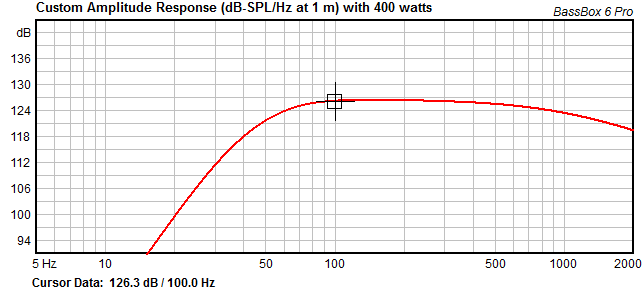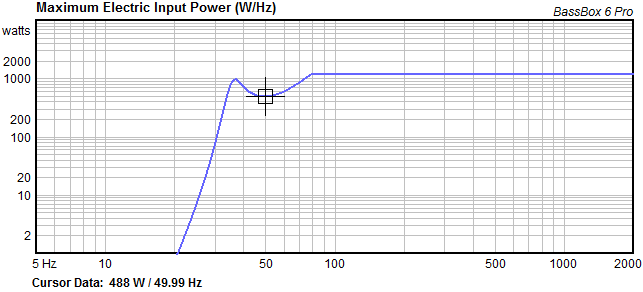In our previous blog post, Sensitivity Sensationalism, we looked at some incorrect assumptions often made around loudspeaker sensitivity and power ratings. We discussed the dangerous practice of publishing inflated specifications, including frequency range, power handling, impedance, and unspecified boundary loading conditions. And we promised a deep dive into the design of a Screen Channel Low Frequency speaker to see that sensitivity and thermal power ratings are not a good way to design an excellent cinema loudspeaker system. So let’s dive in.
Let’s look at a real-world example. To understand the cost, size and bandwidth tradeoffs, we will use two readily available woofers and simulate their performance using a popular cabinet design software called BassBox Pro. Eminence Speaker LLC, has a wide range of products at varying price and performance levels. They publish full driver data for simulation and have list prices available on their website. We will choose two of their high quality, professional woofers and compare the designs.
The Delta Pro 15A is an affordable 15” woofer with high sensitivity and a moderate power rating. The Definimax™ 4015LF is a premium design with a high power rating but a more moderate sensitivity rating.

Let’s look at these woofers with the simplistic design practice in use today. Even with a moderate 400 watt power rating, the SPL calculation for the Delta Pro woofer shows a 2 dB advantage over the Definimax. Why pay nearly $100 more for what looks like lower performance? A deeper look may tell a different tale. Let’s add a few columns to the table.

The Definimax woofer has a 4” voice coil with a much larger surface area for heat dissipation than the smaller 2.5” coil of the Delta Pro. The Definimax is nearly 7 pounds heavier. This is the result of a larger magnet assembly and more steel in the magnetic path resulting in higher magnetic field strength and greater mass for dissipating heat from the voice coil. The Xmax figure is the one-way linear excursion (distance of voice coil travel) of the woofer. The Definimax moves more than twice as far as the Delta Pro, allowing it to have a much higher “displacement limited output” at low frequencies. Going slightly beyond the Xmax limit results in distortion, but go far beyond that and permanent damage occurs.
Any number of performance enhancing features can be added to more sophisticated woofer designs that don’t necessarily show up as improvements in power and sensitivity specifications. Things like undercut pole pieces and shorting rings result in more uniform flux density in the magnetic gap and therefore result in lower distortion. Dual spiders (an internal cone suspension structure) control the cone motion better during large excursions and can increase the durability of the woofer. More exotic magnet materials, like neodymium, can increase magnetic strength and reduce woofer weight, but at a much higher cost. Just looking at power and sensitivity tells very little about the real capability, performance and proper application of a woofer. If the only thing you were told about a vehicle was that it had a 400 horsepower engine, how would you know if it was a truck that could tow a trailer, a sports car that could win a race, or a luxury sedan that could be driven hundreds of miles a day in comfort?
Tuning and Response Curves
Let’s look at some simulations for each woofer. Both woofers have optimal box volumes in excess of 6 cubic feet. This is too large for the average cinema screen channel, so we will go with a more realistic 5 cubic feet. The Delta Pro woofer performs best with a 44 Hz box tuning frequency. The Definimax woofer works best with a 36 Hz tuning frequency. Vented boxes should not be operated at high power without a high pass filter at the tuning frequency, as woofer excursion increases dramatically below the box tuning frequency, and woofer damage is likely to occur. The Definimax system will have an advantage in low frequency extension.
Let’s look at the simulated frequency response curves for both systems. The response curves are normalized to have the same mid-band levels. The Definimax is represented by the blue line and the Delta Pro is represented by the red line. The DefiniMax frequency response is about 6 dB greater at 40 Hz than the Delta Pro.
For live sound reinforcement, this isn’t a big deal since high level PA systems cross the 15” woofers over into subs at about 80 Hz. Cinema screen channels are different. They are intended to be full range, and solid performance down to 35 to 40 Hz is required.
Now let’s look at some simulations based on sensitivity and power ratings. The DefiniMax is rated at 1200 watts and the Delta Pro at 400 watts. Let’s look at the theoretical output at 100 Hz.
Even with the much lower sensitivity, the Definimax has a little over 1 dB greater output at 100 Hz. This is close enough to call it a draw, and isn’t too far off from the simple calculations from the chart above.
If this were all the information we had, the decision would be either to spend less and get reduced low frequency extension or spend more and get better bass at 40 Hz, but the overall levels would be about the same. If thermal power ratings are the only thing to be considered, the cheaper option might be appealing. However, we have to look at mechanical displacement to find the real story here.
Mechanical Displacement
Now we are going to plot the levels with limits due to the mechanical displacement of the woofer. If you recall Xmax from above, the DefiniMax woofer moves about twice as far as the Delta Pro before it reaches the limit of linear operation. The mechanical displacement limit will show up as a frequency dependent curve at low frequencies. The overall operating envelope of the woofer is defined by displacement limits at low frequencies and thermal limits at high frequencies.
The Definimax woofer has a displacement-limited output of 120.1 dB at 50 Hz and the Delta Pro is 117.3 dB at 60 Hz. The extra excursion has resulted in a solid 3 dB advantage for the Definimax woofer. Also note that the Delta Pro falls a massive 10 dB short of the simple calculation of 127 dB maximum level. This situation is usually worse with subwoofers. Now we understand why some systems sound bad at loud levels and why some, especially subs, fail when thermal power ratings are used for designs.
We can convert this graph to show electrical power rating vs. frequency. The Definimax woofer can take 488 watts at 50 Hz before reaching displacement limits and full thermal rated power can be applied above 80 Hz. Perhaps more importantly, about 1000 watts can be applied at 37 Hz. The Delta Pro system reaches displacement limits at 84 watts at 60 Hz and full thermal rated power can be applied above 120 Hz. Only 166 watts can be applied at 45 Hz.
Conclusions
The “simple” calculations might have led us to choose the Delta Pro option since it is cheaper. Output levels were about the same, but the Delta Pro had the advantage of reaching those levels with a much smaller amplifier. The Delta Pro woofer is a fine product for the price and works especially well when crossed over into subwoofers. If deep bass is required, the Definimax woofer is clearly superior. For cinema screen channel applications, the Definimax system plays louder and lower than the Delta Pro.
So how should this affect loudspeaker selection decisions?
Based on the evidence, we suggest you use more, or bigger, or better woofers. Buying better speakers has far more influence on improving sound quality than buying bigger amps for inadequate speakers. Don’t expect woofers to be able to use their full thermal power rating, stay linear, and play with low distortion. And most importantly, don’t believe over-inflated sensitivity specifications that seem too good to be true based on comparisons with other similarly priced competitive models. If it seems too good to be true, it probably is. Good sound isn’t cheap. It requires using better materials and better designs, which very often cost more.
But if all this seems confusing, let us help. We have a team of application engineers who can help you better understand the complexities of these issues, or recommend the best products for your particular application.









Great Blog!
Thanks!